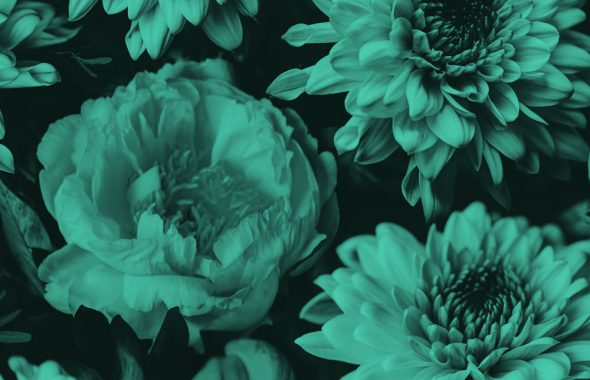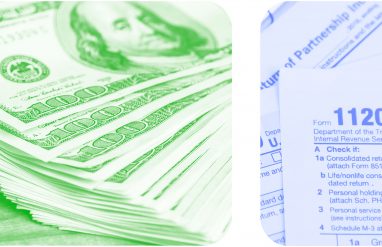Do you know all of your colors? No, we aren’t just talking about red and green. We mean color words like quercitron, puce, and dragon’s blood. There are so many unique and fascinating words that describe shades of color in our language. If you stop at the basics, you might just miss out on some of the most vivid and historically interesting shades that exist. Luckily, we’re here to prevent that. To celebrate all of the colors of the rainbow, and then some, we’ve put together a list of rare color words that are unlike any other. Keep reading for 19 obscure color words you may not have heard before.
1. dragon’s blood
This shade of red has a great name, but we’re sorry to disappoint you: it doesn’t actually come from dragons. Dragon’s blood is also sometimes called Pompeian red, and it’s a “dull, grayish red.” The color is associated with the deep-red resin that exudes from the fruit of palms, like the Malaysian palm and the dragon tree. It was first recorded in English in the 1590s.
2. quercitron
Quercitron might sound like a new type of robot technology, but it’s actually a shade of yellow. It’s named for the yellow dye produced by the bark of an oak tree that’s native to eastern North America. The word is a combination of the Latin quercus, or “oak,” and citron, “a grayish-green yellow color.”
3. ultramarine
If you’re imagining ultramarine as “a deep-blue color,” you are correct. In Medieval Latin, from which this word derives, ultramarinus literally means “beyond the sea.” This is because, historically, pigment from the mineral lapis lazuli was needed to make ultramarine dye, and this mineral had to be imported to Europe from Asia. Ultramarine has been in use in English since the late 1500s.
4. annatto
Annatto is a yellowish-red color, named for the dye that can be obtained from the pulp enclosing the seeds of the tree of the same name. This tree is also sometimes called the lipstick tree, and its dye is still used today to color cosmetics, butter, and cheese. The word annatto was borrowed into English from Carib.
5. Tyrian purple
Looking for “a vivid, purplish red”? Tyrian purple is your color. Tyrian purple was highly prized during the Byzantine empire, in part because of how difficult it was to obtain. The base to create this shade of purple had to be obtained from the secretions of a predatory sea snail. The term Tyrian purple has been in use in English since the late 1500s.
6. Mazarine
Mazarine is “a deep, rich blue,” most commonly associated with textiles and ceramics. The word first entered English between 1665 to 1675, but its origins aren’t fully known. The name may be an homage to a famous Italian cardinal, Cardinal Mazarin, who was culturally influential.
Dive into more words for the color blue.
7. cerulean
Speaking of shades of blue, what about cerulean? Cerulean is best described as “deep blue; sky blue; azure.” In fact, it comes from the Latin caeruleus, meaning “dark blue.” The word has been in use in English since the mid-1600s, though the artist’s cerulean blue emerged closer to the late 1800s.
8. greige
What do you call “a warm beige color with gray undertones”? Greige, of course. This may sound like a trendy compound word that was invented by HGTV in the 2000s, but the color greige has actually been around for a while. Its name was first recorded in English as early as 1925, and it actually comes from the French grège, meaning “raw,” which was used to describe silk.
9. citreous
If the word citreous gives you visions of lemons and limes, you’re on the right track. This color is “lemon-yellow” or “greenish-yellow.” As you may have guessed, it is closely associated with citrus. In Latin, citreus means “of the citrus tree.” We’ve been using this term in English since at least 1865.
10. ponceau
You might see ponceau during a sunset. It means “a vivid reddish-orange color.” It may also make you think of poppies, as it likely derives from the Old French pouncel, or “poppy.” It was first recorded in English as early as 1825.
11. sepia
If you’ve ever used an Instagram filter, you’re probably familiar with sepia. This “brown, grayish brown, or olive brown” is often used in photography to give photos an old-fashioned vibe. The Latin sēpia, from which this word originates, means “cuttlefish” (and this is the creature that secretes the pigment used to create sepia).
12. gamboge
Gamboge is a “yellow or yellow-orange” color. It’s named for the yellow color of gum resin that comes from a type of tree native to Cambodia. Gamboge comes from Modern Latin cambogium, which is the Latin version of the place name Cambodia. This distinctive color name first appeared in English in the early 1600s.
13. lovat
Lovat doesn’t just describe one color. It means “a grayish blend of colors, especially of green, used in textiles, as for plaids.” First recorded between 1905 and 1910, lovat is likely named after Thomas Alexander Fraser, also known as Lord Lovat, who helped popularize tweeds in muted colors as attire for hunters.
14. smaragdine
If something is “emerald-green in color,” you can call it smaragdine. While this term is more rare, smaragd actually means “emerald” in Middle English. It’s likely that English speakers borrowed the term from the Greek smarágdinos, which was probably itself borrowed from Sanskrit marakata. The term has a long history and was first recorded in English as early as 1350.
15. puce
In French, puce means “flea” or “flea-colored.” In English, it’s most often used to describe “a dark or brownish purple.” Historically, it may also have been associated with the color of the scab or mark that a flea bite leaves behind. In any case, this creepy, crawly color word has existed in English since the 1780s.
16. Viridian
Let’s talk about green things, like Kermit the Frog, grass, or viridian. Viridian is the color of “a long-lasting bluish-green pigment.” Its name comes from the Latin viridi or viridis, which literally means “green.” Viridian entered English in the 1800s.
17. heliotrope
Heliotrope may sound like a chemical compound, but it’s actually a color that comes from a plant. It means “a light tint of purple; reddish lavender,” as found on the flowers of several plants belonging to the genus Heliotropium. These plants turn their leaves to the sun, hence their name, which can be traced to the Greek god Helios, or “sun.”
How many other words for purple shades are there? Quite a lot, actually. Discover some here.
18. sable
Sable is another word for the color black. Typically it describes something “very dark or black,” that resembles the fur of an actual sable, an Old World weasel-like mammal. Sable entered English in the late 1200s or early 1300s.
19. wheaten
What color is wheaten? It might not surprise you to find out that this color word is pretty literal. It means “of the color of wheat, especially a pale yellow-brown color.” It’s also among the oldest words on our list, appearing in English before the year 900.
Take the quiz!
Not done with these colors yet? You can revisit this kaleidoscope of terms any time by reviewing our colorful word list. And when you want a special challenge, follow the rainbow over to our rare colors quiz.














